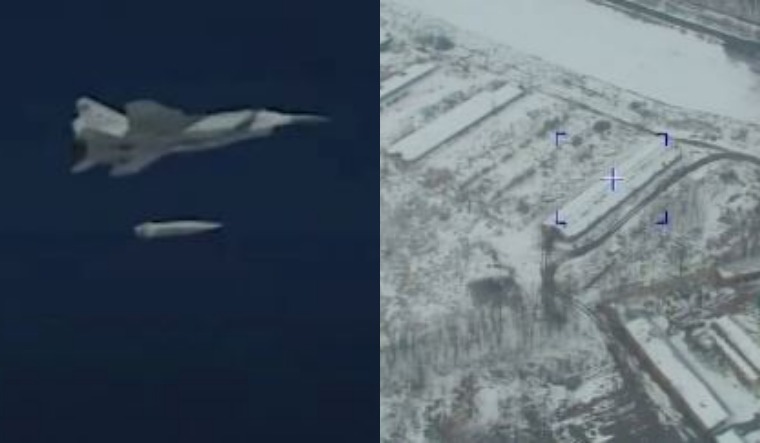Russia on Saturday claimed it had used for the first time in operations in Ukraine a new weapon system that has been previously touted as a game-changer.
Russia's defence ministry claimed that it had used the Kinzhal (dagger) hypersonic missile on Friday to destroy “a large underground warehouse containing missiles and aviation ammunition in the village of Deliatyn in the Ivano-Frankivsk region”. The said target is located in western Ukraine, near the border with Romania.
The Kinzhal was unveiled by Russian President Vladimir Putin in 2018 and is thought to have a speed of up to 10 times that of sound. It is capable of carrying nuclear or conventional warheads to a range of around 2,000km. The Kinzhal is carried and launched by the MiG-31 fighter. The high altitude of the launch aircraft and its high speed makes the Kinzhal very difficult to counter with most surface-to-air missiles.
Video footage shared on Twitter by Russia's defence ministry showed what appeared to be a large warehouse suffering a single explosion.
Doubts
US defence website The Drive expressed doubts about Russia's claim the Kinzhal was used against a target in western Ukraine, based on the video footage. The Drive emphasised sources in the US government claimed the Kinzhal had been used in the conflict, but “maybe its target was different than what was claimed, and this would fit with the discrepancies with the video”.
Just one explosion?
Referring to the video, The Drive noted “There’s also a distinct lack of secondary explosions as one would expect when rocket fuel and explosives cook-off. It’s still possible a Kinzhal hit the base, but the video is suspect at a minimum.”
UAV's limits
The report noted the limited range of the UAV, said to be the Orlan-10, that was used to record the attack. “Orlan-10's range is typically stated to be between 120 and 150 kilometers, or between around 75 and 93 miles. However, it is said to be able to conduct operations out to a range of 600 kilometers, or almost 373 miles, in an 'off-line mode' along a preplanned route where it can record video footage, but not transmit it in real-time...,” The Drive reported.
The Drive claimed to use geolocation to narrow down the target area to eastern Ukraine. The report said “We can now say for certain that the strike depicted happened nowhere near the western part of the country and not at some major military weapons storage area. It happened at a heavily bombarded rural area in the far eastern area of Ukraine.” It showed satellite imagery from Planet Labs of a farm in eastern Ukraine similar to the building shown in the Russian ministry of defence video.
The Drive noted the geolocation of the target to eastern Ukraine “answers our question as to the UAV's presence above the target area. The anti-air threat is nothing in Ukraine's east as it is in the west. This also calls into question, even more, why a missile of Kinzhal's nature would be used on a target close to Russian territory and on what appears to be a farm's barn or large chicken coup.”
Explaining the significance of the geolocation, The Drive noted “it is very unlikely we are seeing a Kinzhal missile being used in the video.”
Doubts about the use of the Kinzhal missile are expected to add to the allegations of disinformation levelled against both Russia and Ukraine.




